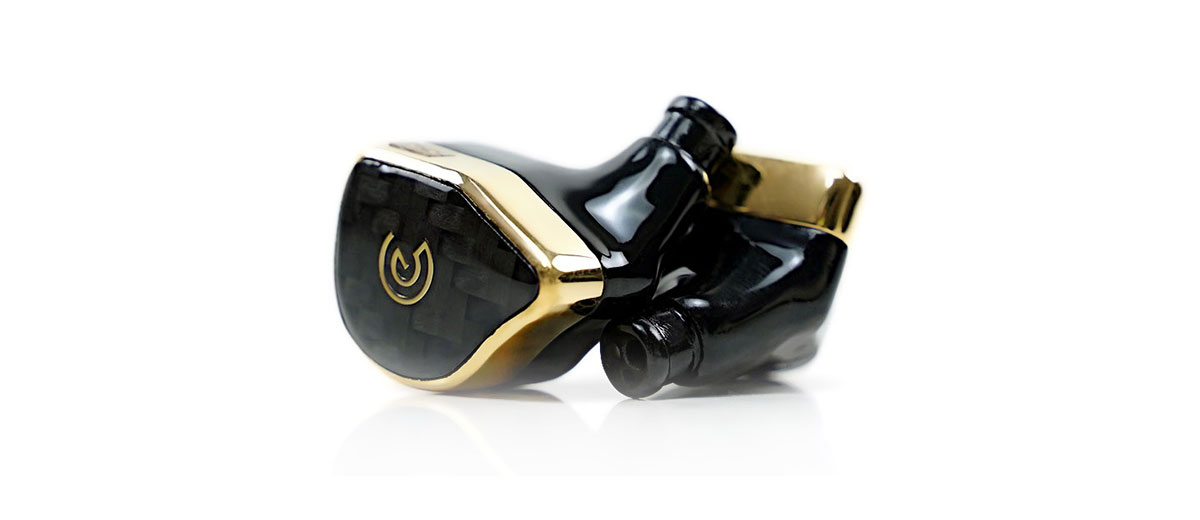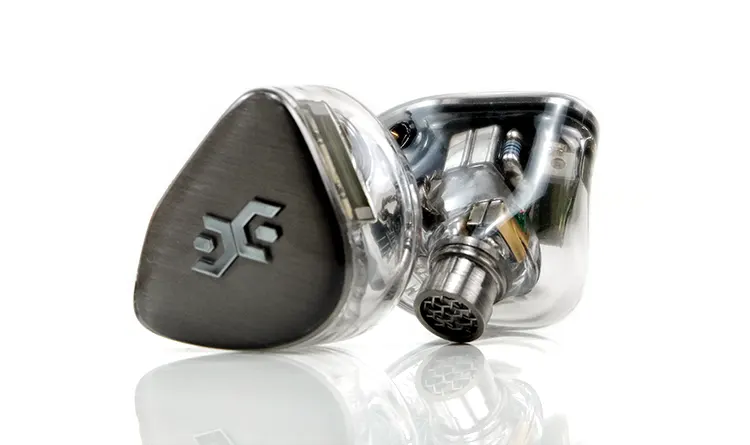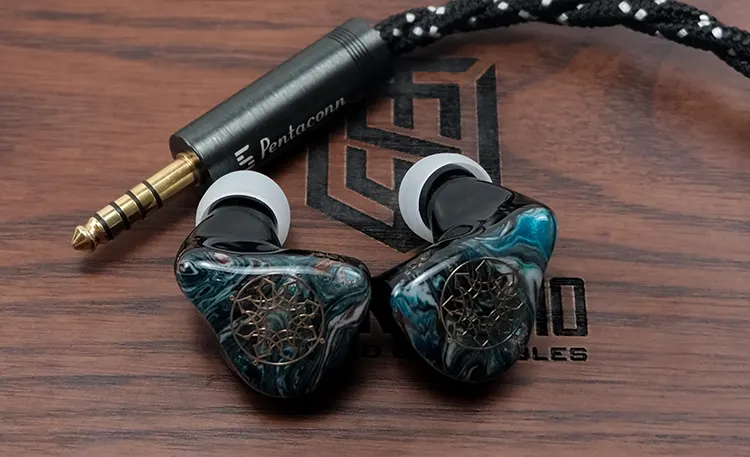Selected Comparisons
The following comparisons to the Craft Ears Omnium were completed using a mix of the HiBy R8 II, the Cayin N8ii, and the Chord Electronics Mojo 2.
Elysian Acoustic Labs Annihilator 2023
The Annihilator 2023 was logically released in 2023 though our review was published just at the start of this year. This is Elysian’s flagship 2nd generation universal IEM.
Technical
The Annihilator 2023 is also a tribrid 7-driver universal IEM but instead of planar it uses a mix of dynamic, BA, and EST drivers with a 4-way crossover.
The precise configuration is a single Foster dynamic driver for the lows, and 4 BA for the mids, with a set of dual Sonion electrostatic tweeters instead of tubeless BA for the highs.
Both IEMs strongly emphasize internal acoustic engineering. The Annihilator 2023 uses a DiVe Pass System for independent front and rear acoustic chamber design around the dynamic driver to assist with air pressure management and a 3D AccuPost System for imaging accuracy.
The Omnium places greater emphasis on the management of the highs with SES 3.0 (Space Expanse System) in the nozzle combined with an entirely tubeless design for the 5 BA drivers which deal with the upper mids, highs, and ultra-highs.
The Annihilator 2023 has a fairly moderate load for an IEM at 22Ω, the Omnium is even lower at 12Ω. Neither is going to be voltage-biased but each has its quirks.
The Elysian flagship has a sensitivity rating of 94 dB @100mV @1khz which is relatively low. The Omnium’s true load means it is less likely to experience impedance skew.
There is no official sensitivity rating for the Omnium so we can only blind test with the HiBy R8 II using the balanced output connector. Thankfully, it is more sensitive than the Annihilator 2023.
Design
Despite different approaches to aesthetics both bias more toward a larger form factor to accommodate the wealth of drivers and tech inside each.
The Annihilator 2023 is mostly resin for materials and is lighter than the Omnium. The Omnium’s 18k gold-plated frame gives it a shinier and heftier feel to the shells.
There are also 3 different versions of the Annihilator 2023 finish that affect the aesthetics.
This sample uses a brushed Titanium plate so it’s a mix of grey and transparent resin. You can also get a gold-plated copper plate version that is a bit closer to the vibe of the Omnium as well as a stainless steel option that brings back the grey tone again.
Overall, the mix of carbon fiber and 18k gold says premium on the label but the Annihilator 2023 still has quite a striking level of finishing to its housing.
Both are very comfortable to wear and quite secure but for passive isolation, the Annihilator 2023 was a better choice, at least for my ears. YMMV but the slightly more rigid lines of the Omnium shell didn’t quite seal as well as the stubby and slightly curvier Elysian Labs design.
I must mention the beast of a cable that comes with the Annihilator 2023. This is a Liquid Links design called the Martini, an 8-wire 26AWG palladium-plated silver and gold-plated copper hybrid with some gorgeous chrome-finished aluminum barrels.
The Omnium 4-wire OCC silver-plated copper cable isn’t as flashy and might have a slightly higher resistance level so not quite as dynamic a performer.
Its plus side though is that it is much lighter, has interchangeable jacks for more connectivity options, and uses a more common 2-pin connector system instead of Pentaconn.
Performance
Such different presentations. So much so that the same track can sound very different when changing from one IEM to the other.
The Annihilator 2023 is warmer, more rounded in its timbre, more elevated in the bass, and narrower in the staging through the mids. It’s an excellent pick for deeper and fulsome modern music with an elongated bass shelf but less magical for nuanced imaging from mid-centric genres and lighter jazz tracks.
The Omnium extends very deep also but is much flatter through the mid-bass and quite neutral through to 1k. There is less of a bass focus with stronger separation so it can sound deep when the music has some energy below 50Hz but conversely, mid-bass-centric music will sound flatter with less warmth.
Its magic is in the mids with a 1-3k bump north of neutral and some enhanced upper-mids and upper treble to elevate both vocal and instrument with a clean and lighter high-contrast tone that fixates your listening focus.
This is a less forgiving midrange sound with poor recordings or sibilance but has an edge in nuanced imaging and space that bring delicate recordings alive.
By contrast, the Annihilator 2023 doesn’t have the same presence or air. Its 1k-2k is slightly south of neutral or will be perceived as such because of that dominant bass shelf up to 200-300Hz. It also dips around 5-6k, an area that the Omnium retains in terms of energy making it a more forgiving performer.
Overall, the Omnium is the brighter of the two IEMs but does better for micro-detail through the mids and highs. It’s my pick for jazz, vocal specialists, and some classical works. The Annihilator 2023’s smoother and weightier performance blends better with punchier modern pop and house music.
Vision Ears VE10
The Vision Ears VE10 was also launched at the tail-end of 2023 with our review coming out at the start of this year. This is the flagship model of their VE line and the first universal non-resin shell design in that series.
Technical
Both are universal hybrid IEMs, however, the VE10 only comes in a universal format whereas the Omnium can also be bought in a custom format. The VE10 is also a hybrid rather than a tribrid with a mix of dynamic and BA as opposed to additional EST or planar drivers.
The precise configuration is a higher driver count of 9 over 7 with a single dynamic driver for the lows, with a dual BA for the low mids, a dual for the mids, another for the mid/highs, and the super tweeter for the ultra-highs using a 5-way crossover.
The VE10 BA drivers are tubed instead of tubeless but like the Omnium, it has a unique acoustic engineering application with a specially designed horn and geometric-shaped sound tubes from the drivers to extend the high-frequency range and minimize turbulence to reduce THD, (“distortion factor”).
The VE10 is one of the more sensitive flagship IEMs out there at 8.4Ω @1kHz and 118.6 dB @100mV@1KHz. Though the Omnium impedance load is not much higher at 12Ω it does use flat impedance True load technology to prevent skew.
Skew is a factor with the VE10 with devices such as the ONIX Mystic XP1 which produced an overly warmed-up upper bass response from the woofer BA drivers.
Design
Both of these IEMs have some distinctive quality designs. They look very different but at the same time, you can tell right away they are premium-level monitors.
The VE10 goes for more of a cyber-punk synthwave style of design that reminds me of the WIPEOUT PlayStation branding with a two-tone mix of ribbed black for the shell and a striking matte silver/grey faceplate. It’s quite a contrast to the more boutique ornamental 18K gold and black with carbon fiber of the Omnium.
Both the shell and plate of the VE10 are made from anodized aluminum with a slimline but long venting port to the front whereas the Omnium is a mix of resin, gold, and carbon fiber.
Surprisingly, it is the Omnium which is the heavier IEM in the hand. Its form factor is much the bigger of the two, particularly in shell depth.
Usually, the use of aluminum would mean a poor passive isolation performance but the shallower depth of the VE10 allows for a closer fit to the ear canal opening with its tips creating a deeper seal. You need to switch to the dual flange tips on the Omnium to get the depth a bit closer.
Both have some decent 4-wire SPC cables though the branding and color scheme of the VE10 barrels are more harmonious with the theme of the shell designs whereas the Omnium cable is a little more detached.
On the flipside, the Omnium cable has the better functionality with its interchangeable modular jack system whereas the VE10 stock cable comes in 4.4mm only.
Performance
The VE10 sits somewhere in between the Omnium and the Annihilator 2023. It does have a longer bass shelf compared to the Omnium and it will generate a bit more body and warmth as a result.
It will also have a creamier smoother midrange, a vocal positioning that is just slightly behind the Omnium equivalent, and a treble tuning that is more attenuated and softer in its application.
What that means is a softer, more conservative presentation from the VE10. One that is very rounded, has excellent bass delivery, engaging vocals, and a treble that doesn’t interfere too much with the even-dominant harmonic balance.
Where the Omnium differs is in that bass shelf again and the greater amount of post-5k treble energy. IMHO, the Omnium is just marginally more elevated 20-40hz but not by much.
You might not pick it up because of the VE10’s elongated shelf that drops slowly only hitting neutral into the lower-mids around 700Hz. Of the two, the VE10 bass will present itself as the ‘bigger sounding’.
The Omnium lows are flatter for longer and carry far less warmth and punch. That means it’s not as fulsome but improves on the bass to mids separation creating a stronger perception of depth and space.
Combine that with more post-6k treble elevation and the balance again swings to the mids and highs for the main listening focus for the majority of instrumental music on the Omnium.
That 1-2k bump gives additional focus to the Omnium vocals beyond the cleaner high-contrast timbre. The VE10’s vocals are also immediate but slightly softer in their tonal balance.
SWEEAR SR11
This is one of those Hong Kong indie brands we had the pleasure of introducing to our readers last year. This is their TOTL monitor from their Reference Series of IEMs and you can read our review of the SR11 here.
Technical
Like the Omnium sample we have here, the SWEEAR SR11 is a universal ‘tribrid’ multi-driver in-ear monitor. However, its count and composition are higher at 11 drivers with a mix of dynamic, balanced armature, and electrostatic variations combined with a 5-way crossover. There is no use of a planar driver.
The SR11’s precise driver grouping uses the dynamic driver primarily for sub-bass frequencies only and 2 BA for the mid to upper bass.
You get a further 4 BA above that with 2 for the mids and 2 for the mid-to-high frequencies and a quad electrostatic driver array for the highs/ultra-highs. All BA drivers in the SR11 are tubed using the company’s Independent Pipeline Purify (IPP) micro-acoustic technology for dynamic range and note ‘density’.
The SR11 is rated at 14Ω and 112 dB @1kHz mW which puts it in the fairly easy-to-drive category though with EST drivers we find they tend to be slightly less efficient than the paper ratings. It does not use flat impedance technology but I have yet to experience any skew with its driver makeup.
There is no official SPL rating for the Omnium but testing with the Cayin N8ii using a low gain balanced output I did find it to be a little bit less sensitive to volume adjustments compared to the SR11.
Design
I can’t fault the SR11 shell design. It’s intricate, blending greens, greys, and blacks. However, it is a bit of a plain jane compared to the opulence of the Omnium shell materials.
Arguably, the SR11 has more of a ChiFi vibe albeit at a more premium level with its cheaper two-tone all-resin build. That said, the resin is aggressively contoured to sit flush in your ear and up tight against the ear canal with excellent insertion depth.
The SR11 isolates a bit more than the Omnium despite both being vented designs with similar single-flange narrow bore tips. The SR11 also feels a bit more secure in the ear though the comfort levels are much the same.
Both IEMs use stock cables with modular jack designs. You also get an additional 2.5mm TRRS plug with the SR11 which is not an available option with the Omnium.
However, I find the finishing on the SR11 plugs and the cable in general to be a bit more ‘old-school’ with the classic carbon fiber on aluminum finish I used to see on cables from 5-6 years ago.
The SR11 stock cable is an 8-wire high-purity silver-plated copper Litz geometry so double the core count on the SPC 4-wire Omnium cable. However, the net result is that it is a thicker and heavier cable, especially with the bulkier barrels.
Both cables are low in microphonics and exhibit excellent handling capabilities with zero memory retention.
Performance
If the VE10 is between the Annihilator 2023 and the Omnium then the SR11 is between the VE10 and the Omnium. Of the three compared IEMs, it is the one that comes closest in terms of tonal profile and a general sense of good speed and precision.
Where it differs primarily is the amount of elevation in the bass shelf and treble energy. Compared to the Omnium, the mid-bass punch of the SR11 is more dominant with a bit more perceived warmth though not as much as the other IEMs.
That does give the mids timbre a slightly smoother tonal profile but overall, it is still a relatively lighter tone compared to the VE10 or the Annihilator 2023. It is not quite as high in tonal contrast or as spacious as the Omnium’s mids nor is the vocal presence quite as forward around 1-2k.
The Omnium treble energy beyond 6k is more concerted and energetic and does play a stronger role in the mids timbre but the SR11 is not that far off either. It’s a fairly clean and precise tone from the SWEEAR flagship that benefits slightly from the enhanced low-end warmth.
The staging is what sets these two apart in a more significant manner. The SR11 digs deeper, sounding more planted and authoritative but from the mids upwards it’s not as expansive as the Omnium nor as open-sounding, especially once you move into the highs.
The potential dynamic range from the SR11 is on par with the Omnium. At times one can best the other. The speed from the SR11 drivers is excellent so while not as open sounding, its ability to create a resolving soundstage is just as good.
My Verdict
The Craft Ears Omnium clearly belongs at the high-end monitor table along with the likes of current audiophile darlings such as the VE10 and the Annihilator 2023.
This is a performance that is rich in detail, neutral in tone, and delightfully immersive in its presentation. And boy, does the lows scale beautifully with quality power running through it.
Some will argue that it’s perhaps more to the bright side and I get that. Certain sources and tip combinations will give it a cleaner sound than others, certain recordings will do similar. However, find a smooth and dense-sounding source, and it’s a dynamic tour de force.
Craft Ears has come a long way since I last reviewed their gear. The Omnium is an obvious example of just how far that journey has come.
Craft Ears Omnium Technical Specifications
- Drivers: 9.2mm LSR dynamic driver, 10mm Planar driver, 5 tubeless BA drivers
- Crossover: 6-Way
- Frequency Response: 8 Hz – 40 kHz
- Impedance: 12Ω
- Isolation: -26 dB






